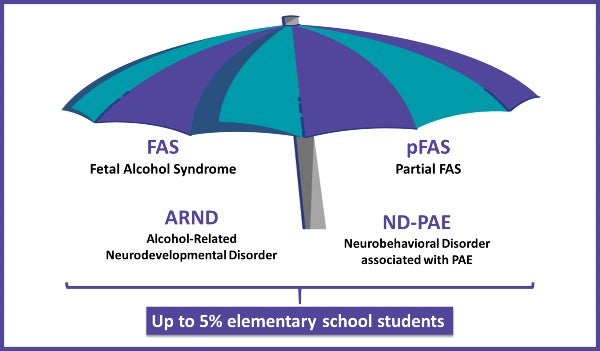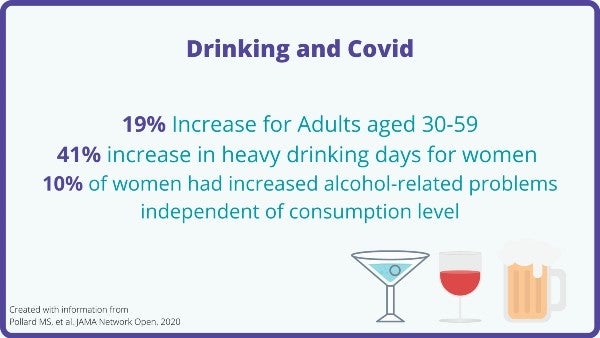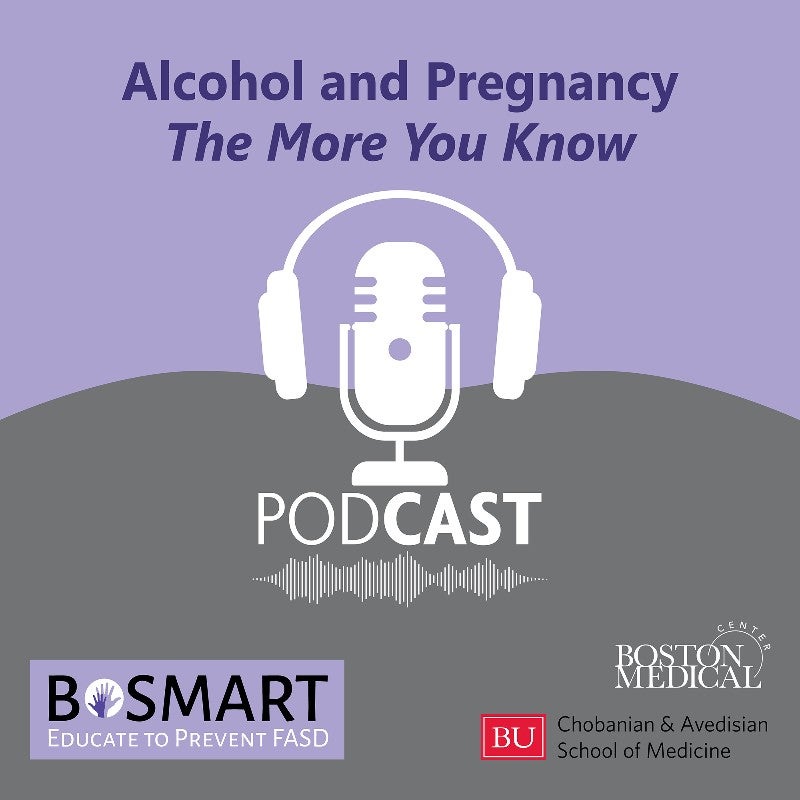
B SMART is a CDC -funded program aimed to prevent fetal alcohol spectrum disorders (FASDs) by providing tailored education and technical assistance to Boston HealthNet Patient Care Teams (Boston Medical Center & 12 Community Health Centers).
Season 2 of our podcast is now available!
About B SMART
B SMART (Boston Sustainable Models for unhealthy Alcohol use ReducTion) is a Centers for Disease Control and Prevention (CDC) cooperative agreement aimed to prevent fetal alcohol spectrum disorders (FASDs) and the risks associated with prenatal alcohol exposure (PAE). This aim will be accomplished by providing tailored education and technical assistance on Screening, Brief Intervention, and Referral to Treatment (SBIRT) for risky alcohol use to Boston HealthNet (Boston Medical Center and the associated 12 community health centers) healthcare teams.
About Prenatal Alcohol Exposure (PAE)
Prenatal exposure alcohol (PAE) is notably the most common preventable cause of intellectual and developmental disabilities in the US.1 Alcohol is a teratogen and exposure to alcohol in utero can result in a range of developmental and physical challenges across a spectrum of disorders- FASDs. Alcohol at any stage in a pregnancy can have negative impacts as alcohol readily crosses the placenta.2 Therefore, this is a considerable issue as alcohol use among pregnant people and before pregnancy occurs commonly. One challenge in gaining precise data and information is shame and stigma surrounding prenatal alcohol exposure.3 As nearly half of pregnancies are unplanned it is important to have a discussion about alcohol use before pregnancy.4
About FASDs
Fetal alcohol spectrum disorders is an umbrella term and the impact of PAE exists across a spectrum of conditions within the umbrella of FASDs. These conditions include Fetal Alcohol Syndrome (FAS) and partial FAS (pFAS), Alcohol-Related Birth Defects (ARBD), Alcohol-Related Neurodevelopmental Disorder (ARND), and Neurobehavioral Disorder Associated with Prenatal Alcohol Exposure (ND-PAE).5 Each varies in characteristics and occurrence. FASD impact as much as 5% of school aged children.6 Diagnosis criteria can vary for each of the FASD.7

Why Now?
According to a recent CDC MMWR, it is evident the drinking during pregnancy continues to be a significant problem. In the pregnant adults surveyed:
- 13.5% reported current drinking
- 5.2% reported binge drinking
This reflects a 2 percent increase in both categories since the 2015-2017 period.
During the Covid-19 pandemic there are reports of increases in heavy drinking and increases in alcohol-related problems independent of consumption level. Participating in a B SMART training can provide skills and knowledge that will make an important impact on your patients.

What We Offer
Education & Technical Assistance
- Trainings will provide up-to-date information about FASDs and skills in substance use screening, brief intervention and referral to treatment (SBIRT) including motivational interviewing (MI) techniques.
- Continuing Medical Education (CME/CNE) credits offered for most trainings.

- Podcast: This 3-part podcast features interviews with a variety of individuals to explore the many facets of FASDs. We meet with a medical expert in the field of FASDs, a patient advocate, a mother whose child is affected by prenatal alcohol exposure, and a public health social worker specializing in counseling patients in unhealthy alcohol use. https://cme.bu.edu/fasdpodcast
Communication Resources
- Online and hardcopy FASD & SBIRT resources for providers, patients and clinic administrators.
- Creation of infographics
- SBIRT Cards
Reporting and Data
- Real-time virtual feedback on provider training, SBIRT implementation and FASD prevention metrics.
- Robust process and outcome evaluation based on a mixed-methods approach
Funding Source
Funding provided by the U.S. Department of Health and Human Services, Centers for Disease Control and Prevention, cooperative agreement number NU84DD000002
Learn More
- Check out our new podcast!
- About FASDs from the CDC
- About getting continuing education credit
Sources Cited
Text
- Popova S, Dozet D, Burd L. Fetal alcohol spectrum disorder: can we change the future? Alcohol Clin Exp Res. 2020;44(4):815-819. https://doi.org/10.1111/acer.14317
- Center for Disease Control and Prevention. Alcohol Use in Pregnancy. https://www.cdc.gov/ncbddd/fasd/alcohol-use.html. Accessed May 10, 2018.
- Tan C, Denny C, Cheal N, Sniezek J, Kanny D. Alcohol Use and Binge Drinking Among Women of Childbearing Age — United States, 2011–2013. Morb Mortal Wkly Rep. 2015;64(37):1042-1046. https://www.jstor.org/stable/24856791
- Finer LB, Zolna MR. Declines in unintended pregnancy in the United States, 2008-2011. N Engl J Med. 2016;374(9):843-52. https://www.nejm.org/doi/full/10.1056/nejmsa1506575
- Centers for Disease Control and Prevention. Basics about FASDs. https://www.cdc.gov/ncbddd/fasd/facts.html. Accessed May 10, 2018.
- Popova S, Dozet D, Burd L. Fetal alcohol spectrum disorder: can we change the future? Alcohol Clin Exp Res. 2020;44(4):815-819. https://doi.org/10.1111/acer.14317
- Proof Alliance. Diagnostic Terms: Fetal Alcohol Spectrum Disorders (FASD). https://www.proofalliance.org/resource/diagnostic-terms-fetal-alcohol-spectrum-disorders-fasd. 2021.
- Gosdin LK, Deputy NP, Kim SY, Dang EP, Denny CH. Alcohol Consumption and Binge Drinking During Pregnancy Among Adults Aged 18–49 Years — United States, 2018–2020. MMWR Morb Mortal Wkly Rep 2022;71:10–13. DOI: http://dx.doi.org/10.15585/mmwr.mm7101a2
Images
- CDC Vital Signs. https://www.cdc.gov/vitalsigns/pdf/2016-02-vitalsigns.pdf ; 2016.
- May PA, Chambers CD, Kalberg WO, et al. Prevalence of fetal alcohol spectrum disorders in 4 US communities. JAMA. 2018;319(5):474-482. doi:10.1001/jama.2017.21896
- SAMHSA. 2014.
- Centers for Disease Control and Prevention. Basics about FASDs. https://www.cdc.gov/ncbddd/fasd/facts.html. Accessed May 10, 2018.
- CDC, Denny CH, Acero CS, Naimi TS, Kim SY. Consumption of Alcohol Beverages and Binge Drinking Among Pregnant Women Aged 18–44 Years — United States, 2015–2017. MMWR Morb Mortal Wkly Rep 2019;68:365–368. DOI: http://dx.doi.org/10.15585/mmwr.mm6816a1
- http://www.fasdcenter.org/projects/educational-equity/1-in-20-more-common-than-autism
B SMART Team
Our Team:
- Medical Director Daniel P. Alford, MD, MPH
- Program Director Jacqueline S. German, MPH
- Program Evaluator Jacey A. Greece, DSc, MPH
- Program Evaluation Manager Candice Bangham, MPH
- Program Coordinator Amy Harlowe, MPhil
Contact Person: Jacqueline German, MPH
Email: Jacqueline.German@bmc.org
Daniel P Alford, MD, MPH

